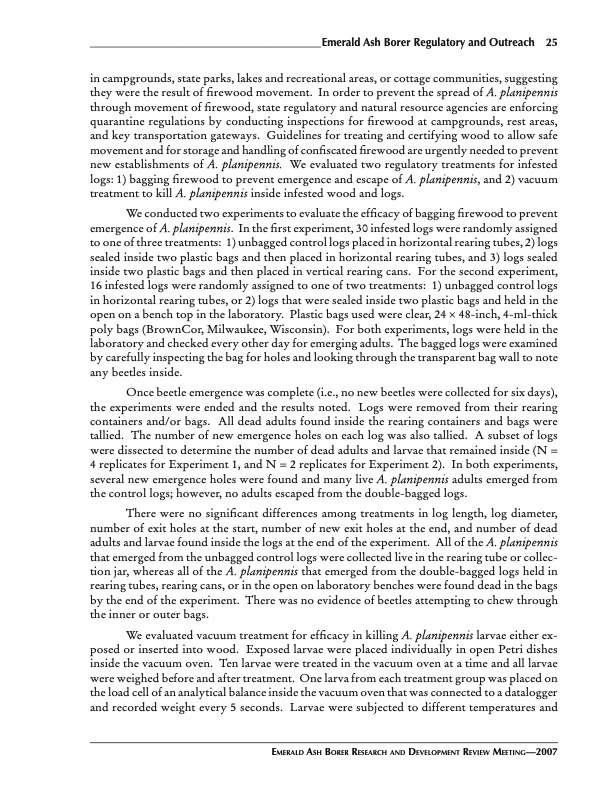
PDF Publication Title:
Text from PDF Page: 002
__________________________________________Emerald Ash Borer Regulatory and outreach 25 in campgrounds, state parks, lakes and recreational areas, or cottage communities, suggesting they were the result of firewood movement. In order to prevent the spread of A. planipennis through movement of firewood, state regulatory and natural resource agencies are enforcing quarantine regulations by conducting inspections for firewood at campgrounds, rest areas, and key transportation gateways. Guidelines for treating and certifying wood to allow safe movement and for storage and handling of confiscated firewood are urgently needed to prevent new establishments of A. planipennis. We evaluated two regulatory treatments for infested logs: 1) bagging firewood to prevent emergence and escape of A. planipennis, and 2) vacuum treatment to kill A. planipennis inside infested wood and logs. We conducted two experiments to evaluate the efficacy of bagging firewood to prevent emergence of A. planipennis. In the first experiment, 30 infested logs were randomly assigned to one of three treatments: 1) unbagged control logs placed in horizontal rearing tubes, 2) logs sealed inside two plastic bags and then placed in horizontal rearing tubes, and 3) logs sealed inside two plastic bags and then placed in vertical rearing cans. For the second experiment, 16 infested logs were randomly assigned to one of two treatments: 1) unbagged control logs in horizontal rearing tubes, or 2) logs that were sealed inside two plastic bags and held in the open on a bench top in the laboratory. Plastic bags used were clear, 24 × 48-inch, 4-ml-thick poly bags (BrownCor, Milwaukee, Wisconsin). For both experiments, logs were held in the laboratory and checked every other day for emerging adults. The bagged logs were examined by carefully inspecting the bag for holes and looking through the transparent bag wall to note any beetles inside. Once beetle emergence was complete (i.e., no new beetles were collected for six days), the experiments were ended and the results noted. Logs were removed from their rearing containers and/or bags. All dead adults found inside the rearing containers and bags were tallied. The number of new emergence holes on each log was also tallied. A subset of logs were dissected to determine the number of dead adults and larvae that remained inside (N = 4 replicates for Experiment 1, and N = 2 replicates for Experiment 2). In both experiments, several new emergence holes were found and many live A. planipennis adults emerged from the control logs; however, no adults escaped from the double-bagged logs. There were no significant differences among treatments in log length, log diameter, number of exit holes at the start, number of new exit holes at the end, and number of dead adults and larvae found inside the logs at the end of the experiment. All of the A. planipennis that emerged from the unbagged control logs were collected live in the rearing tube or collec- tion jar, whereas all of the A. planipennis that emerged from the double-bagged logs held in rearing tubes, rearing cans, or in the open on laboratory benches were found dead in the bags by the end of the experiment. There was no evidence of beetles attempting to chew through the inner or outer bags. We evaluated vacuum treatment for efficacy in killing A. planipennis larvae either ex- posed or inserted into wood. Exposed larvae were placed individually in open Petri dishes inside the vacuum oven. Ten larvae were treated in the vacuum oven at a time and all larvae were weighed before and after treatment. One larva from each treatment group was placed on the load cell of an analytical balance inside the vacuum oven that was connected to a datalogger and recorded weight every 5 seconds. Larvae were subjected to different temperatures and EmErald ash BorEr rEsEarch and dEvElopmEnt rEviEw mEEting—2007PDF Image | Evaluation of Firewood Bagging and Vacuum Treatment for Ash Borer

PDF Search Title:
Evaluation of Firewood Bagging and Vacuum Treatment for Ash BorerOriginal File Name Searched:
nrs_2008_poland_001.pdfDIY PDF Search: Google It | Yahoo | Bing
5,000 BF Shipping Container Lumber Dry Kiln For Quality Lumber The 5,000 BF container kiln consists of one 40 foot high-cube aluminum shipping container... More Info
Shipping Container Lumber Dry Kilns by Global Energy Global Energy designed and developed the container kiln back in 1991. The purpose is to give access to portable sawmill owners, furniture makers, and small business the value added profit of dry kiln lumber and quality hardwoods... More Info
Vacuum Kiln Conversion Kit for Lumber and Wood Dry Kilns Convert your existing conventional dry kiln into a fast drying vacuum kiln. Similar to vacuum bagging in the boat building and aircraft industry, we have come up with a proprietary process which allows you to build a very simple vacuum kiln at a fraction of the price, and without the intensive conventional metal chamber structure... More Info
Vacuum Pump Cart System for Bagging Clamping Wood Drying and more Vacuum Cart with 2HP Pump and Dual Pistons with multiple multiplex vacuum ports and liquid reservoir... More Info
Vacuum Bagging Basics Vacuum bagging is a method of clamping, which has traditionally been used in the composites industry, but can also be used for vacuum drying materials, including wood products... More Info
| CONTACT TEL: 608-238-6001 Email: greg@globalmicroturbine.com | RSS | AMP |